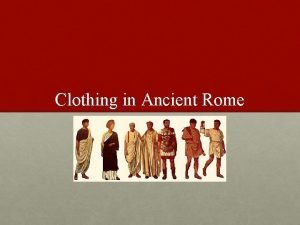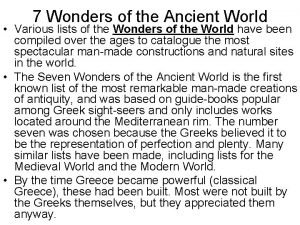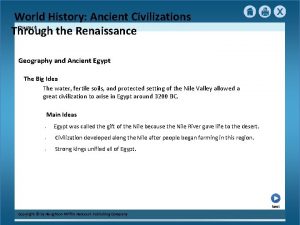Lesson 4 Clothing in the Ancient World From



















- Slides: 19

Lesson 4: Clothing in the Ancient World From Wayne Jackson’s book

Clothing in Ancient World

Clothing in Ancient World • Animal hides – Used for clothing throughout human history • Esau’s skin compared to “hairy garment” (Gen. 25: 25) • Elijah likely wore a “garment of hair” held secure by a leather belt (cf. 2 Kgs. 1: 8 ASVfn)

Clothing in Ancient World • Flax – Grown in Egypt (Ex. 9: 31) and Canaan (Josh. 6: 2) was of the earliest textile fabrics made into linen (cf. Prov. 31: 13 -14) • When Joseph was made ruler in Egypt, he was clothed in “fine linen” (Gen. 41: 42) • The attire of the Jewish priests was of linen (Ex. 28: 6, 15; 39: 27 -29; cf. Ezek 44: 17 -18) • Used symbolically for the righteous acts of the saints in Rev. 19: 8

Clothing in Ancient World • Wool – Manufactured from the fleece of sheep and goats • Wives of Israel wove clothing for their families (Ex. 35: 24; Prov. 31: 13) • Wool was sold and traded in ports such as Tyre (Ezek. 27: 15) • Tribute was even paid using wool (2 Kgs. 3: 4) – Wool could be washed white (Isa. 1: 18) • Or dyed various colors (cf. Heb. 9: 19) – Jews were forbidden to wear a garment containing a mixture of wool & linen (Deut. 22: 11).

Clothing in Ancient World • Sackcloth – Strong, rough cloth woven from the long hair of the Oriental goat or camel – Most often, sackcloth was used in times of mourning and penitence

Clothing in Ancient World • Sackcloth – Most often, sackcloth was used in times of mourning and penitence Jacob when believed Joseph was dead (Gen. 37: 34) David commanded to mourn death of Abner (2 Sam. 3: 31) When Ahab heard prophetic doom of Jezebel, he put on and lay in sackcloth as a token of repentance (1 Kgs. 21: 27) – his contrition was short-lived • Jonah preached repentance to Nineveh, and their response was reflected in wearing sackcloth (Jonah 3: 5 -6) • The prophets sometimes wore sackcloth as a symbol of their message of repentance (Isa. 20: 2; Zech. 13: 4) • John the Immerser wore a “raiment of camel’s hair” (i. e. , a coarse garment woven from camel’s hair), setting him apart from the regal apparel of softness (cf. Matt. 3: 4; 11: 8). • • •

Clothing in Ancient World • Undergarment – Jewish men normally wore an undergarment, outer robe, belt, sandals & sometimes a hat – The undergarment was a tunic of light material (linen or wool) worn next to the skin. – The undergarment came down to the knees or ankles – To be clad only in this undergarment was to be considered naked (cf. 1 Sam. 19: 24; John 21: 7)

Clothing in Ancient World • Outer Garment – A man’s outer garment (called a coat, robe or mantle) was a square or rectangular piece of cloth wrapped around the body or thrown over the shoulders

Clothing in Ancient World • Outer Garment – The Jews attached “fringes” to the edges of the mantles • The “fringes” reminded them of the precepts of the Law (cf. Num. 15: 38 -39; Deut. 22: 12) • The Pharisees were accustomed to enlarging these “borders” in order to attract attention to themselves (Jesus rebuked, Matt. 23: 5).

Clothing in Ancient World • Outer Garment – Outer mantles sometimes used as “sacks” to carry items • When the Jews left Egypt, they took their kneadingtroughs “bound up in their clothes upon their shoulders” (Ex. 12: 34; cf. 2 Kgs. 4: 39) • The hollow formed by the upper part of this loose garment was called one’s “bosom” (a large pocket secured by the belt) – Just before Israel went into captivity, God warned that He would recompense their iniquities “into their bosom” (Isa. 65: 5), filled with punishment (cf. Jer. 32: 18; Psa. 79: 12). – “Give, and it will be given to you: good measure, pressed down, shaken together, and running over will be put into your bosom” (Luke 6: 38) – symbolic of going to market where merchant fills one’s sack to complete capacity (cf. Ruth 3: 15)

Clothing in Ancient World • Outer Garment – Jesus stressed the conciliatory attitude to characterize His disciples • “If anyone wants to sue you and take away your tunic [chiton, inner garment], let him have your cloak [himation, outer raiment] also” (Matt. 5: 40) – In this passage, Jesus is referring to a legal process—the claimant is supposed to claim the inner garment (the less costly). The defendant is to be willing to let him have the more valuable one too. • “And from him who takes away your cloak [himation, outer raiment], do not withhold your tunic [chiton, inner garment] either” (Luke 6: 29) – In this passage, Jesus is referring to an act of violence, and there is no mention of going to law. So the outer garment is the first one to be seized.

Clothing in Ancient World • Outer Garment – The soldiers who crucified Jesus took his “garments” (plural), likely both the inner and outer apparel. • The outer mantle was divided between the four soldiers • The undergarment, the tunic (ASVfn), was seamless, hence, the soldiers cast lots for it (John 19: 23 -24) – a fulfillment of prophecy (Psa. 22: 18) • Josephus wrote of the robe of the high priest – It “was not composed of two pieces, nor was it sewed together upon the shoulders and sides, but it was one long vestment so woven as to have an aperture for the neck…” (Antiquities, III, vii, 4). – Was this (speculation) a divine suggestion that Christ was about to enter into His role as our high priest (cf. Heb. 4: 14 -15)?

Clothing in Ancient World • Girdle/Belt – Used to secure either the undergarment or outer garment • Might be made of woven linen (the “band” for Aaron’s ephod, Ex. 28: 8) or of leather (John the Baptist wore, Matt. 3: 4) • Girdle could be a square or triangle cloth, folded to make a strip about 4” wide • Might be fastened with a buckle/clasp or tied in a knot • Might contain a slit to hold coins, an inkhorn or perhaps a dagger • Sometimes women made these girdles and sold to neighboring merchants (cf. Prov. 31: 24)

Clothing in Ancient World • Girdle/Belt – God instructed Jeremiah to purchase a linen girdle (Jer. 13: 1 -11) • Not to be put in water (washed) but worn until it became filthy • Later, Jeremiah was told to go to the Euphrates & hide the belt in a rock crevice • Eventually, he was sent to retrieve the girdle and found it “marred” and “profitable for nothing” • Meaning: “After this manner I will mar the pride of Judah, and the great pride of Jerusalem. ” – God had chosen Israel & Judah to cleave to Him, like the girdle was wrapped to cleave to Jeremiah – As the symbolic belt decayed and became unfit for use, so God would reject these apostate people.

Clothing in Ancient World • Girdle/Belt – When a man was preparing for vigorous activity, he would lift his outer robe and secure it with the girdle, giving his legs greater mobility for running, working, etc. • After Job had repeatedly complained that God was persecuting him (by all the difficulties that had entered his life), the Lord humbled Job with a grueling series of questions about the earth and its creatures. – God prefaced His examination with a warning: “Gird up now thy loins like a man” (Job 38: 3; 40: 7). – In other words, “Job, get ready for a contest!”

Clothing in Ancient World • Girdle/Belt – During the last supper which Jesus ate with His disciples, the Lord arose from the table, laid aside his “garments” (plural—the outer robe and perhaps the girdle that secured it). • He “took a towel and girded Himself” (John 13: 4) • Assuming the role of a servant (cf. 1 Sam. 25: 41), He washed the disciples’ feet, thus teaching a powerful lesson in humility (cf. 13: 14 -16). • No doubt Peter had this vivid scene in mind when he later wrote: “Yes, all of you be submissive to one another, and be clothed with humility, for ‘God resists the proud, But gives grace to the humble’” (1 Pet. 5: 5; cf. 2 Pet. 1: 13).

Clothing in Ancient World • Footware – The poorest of people often went barefooted, though most folks had footware – When they went indoors, they went barefooted • Sinful woman wept at Jesus’ feet and wiped His feet with her hair and kissed them (Luke 7: 36 ff) • Hospitable practice to provide one’s visiting guest with water for washing his feet • How very crude for Simon the Pharisee to criticize the women who “washed” Jesus’ feet with her tears, when he had not even provided Jesus with plain water for that chore (Luke 7: 44).

Clothing in Ancient World • Footware – Since servants usually performed the task of feetwashing (cf. 1 Sam. 25: 41), no question as to what lesson the Master was teaching when He washed His disciples’ feet (John 13: 16). • The path to greatness was through servitude – Certain widows were not qualified for the “enrollment” unless they had “washed the saints’ feet” (1 Tim. 5: 9 -10) • In other words, these older women already had a distinguished record of showing concerned hospitality for the Lord’s people
 Clothing in the ancient world
Clothing in the ancient world Kolambigas
Kolambigas Ancient egyptian clothing
Ancient egyptian clothing Clothing in ancient rome
Clothing in ancient rome Hungarian traditional clothing
Hungarian traditional clothing Ancient egyptian commoner clothing
Ancient egyptian commoner clothing Traditional clothing around the world
Traditional clothing around the world Ancient time ancient means of communication pictures
Ancient time ancient means of communication pictures Ancient india vs ancient china
Ancient india vs ancient china Map of seven wonders of the ancient world
Map of seven wonders of the ancient world Collosus of rhodes
Collosus of rhodes Map of the seven wonders
Map of the seven wonders History alive the ancient world chapter 8
History alive the ancient world chapter 8 History alive chapter 14
History alive chapter 14 From hunters and gatherers to farmers worksheet
From hunters and gatherers to farmers worksheet 7 wonders of the ancient world names
7 wonders of the ancient world names 7 wonders of the ancient world map
7 wonders of the ancient world map Ancient civilizations of the old world map
Ancient civilizations of the old world map World history ancient civilizations through the renaissance
World history ancient civilizations through the renaissance Hình ảnh bộ gõ cơ thể búng tay
Hình ảnh bộ gõ cơ thể búng tay




































